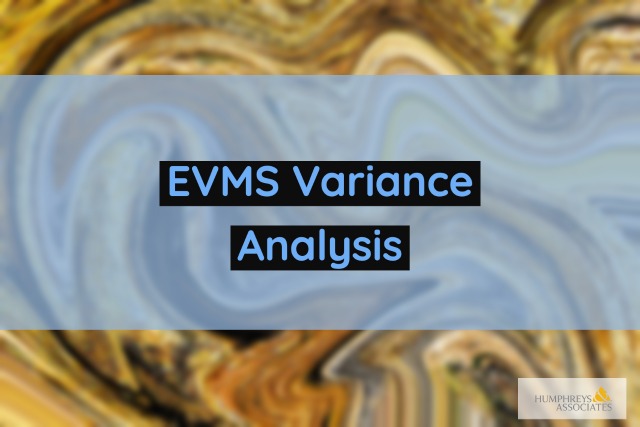Video Release – Assessing Schedule Risk Using Deltek’s Acumen Risk 6.1 | Part 2 of 2
Video Release – Assessing Schedule Risk Using Deltek’s Acumen Risk 6.1 | Part 2 of 2 Read Post »

A Variance Analysis Report (VAR) that includes specific information about the cause, impact, and corrective action “provides management with early insight into the extent of problems and allows corrective actions to be implemented in time to affect the future course of the program” [reference: NDIA, IPMD EIA-748 (Revision D) EVMS Intent Guide]. Unfortunately, variance analysis is an easy target for criticism during EVMS reviews. There are many examples of inadequate variance analysis to choose from, but what they all have in common is the lack of specific information on the “why, what, how, when, and who” of any variance. The variance analysis reporting requirements are found in the EIA-748 (Revision D) Guidelines in Section IV., Analysis and Management Reports, Guidelines 22-27.
| EIA-748 Guidelines Section IV. Analysis and Management Reports |
||
|---|---|---|
| 22 | 2-4a | Control Account Monthly Summary, Identification of CV and SV |
| 23* | 2-4b | Explain Significant Variances | Earned Value Management |
| 24 | 2-4c | Identify and Explain Indirect Cost Variances |
| 25 | 2-4d | Summarize Data Elements and Variances thru WBS/OBS for Management |
| 26* | 2-4e | Implement Management Actions as Result of EVM Analysis |
| 27* | 2-4f | Revise EAC Based on Performance Data; Calculate VAC |
A VAR that includes specific information and data about a problem will allow management to make informed decisions and mitigate project risk. Getting specific about variance analysis reporting includes the following elements.
Ask yourself, is the analyses presented in a manner that is understandable? Does the data support the narrative? Does the variance explanation provide specifics of:
“why” the problem occurred,
“what” is impacted now or in the future,
“how” the corrective action is being taken,
“when” the corrective actions will occur,
“when” the schedule variance will become zero, and/ or the work gets “back on schedule”
“who” is responsible for implementing the corrections?
Remember, a well-developed Variance Analysis Report can reduce the risk of a Corrective Action Request (CAR) during an EVMS review.
EVMS Variance Analysis — EVMS Analysis and Management Reports Read Post »
 As you know, the Earned Value Management System (EVMS) is a management process with characteristics that are absolutely logical to manage projects whether there is an external customer or not. The EVMS is also required by the Federal Government on DOD, DOE, FAA, NSA, DOT, DOJ, NASA, etc. contracts over $20M.
As you know, the Earned Value Management System (EVMS) is a management process with characteristics that are absolutely logical to manage projects whether there is an external customer or not. The EVMS is also required by the Federal Government on DOD, DOE, FAA, NSA, DOT, DOJ, NASA, etc. contracts over $20M.
With the phasing in of the Affordable Health Care Act and recent funding for research and preparation in the event of bio-terrorism, other branches of the Government, such as Health and Human Services (HHS) and Biomedical Advanced Research and Development Authority (BARDA), are becoming more involved in the healthcare sector. Implementing and using EVMS is a baseline requirement for biotech and pharmaceutical firms awarded large contracts by the Federal Government.
This will require companies and universities that receive funding to understand and implement Earned Value Management and that key project personnel, including management and executives, will require high quality Earned Value Training.
Earned Value Management has been used since the 1960’s and has become the standard by which the Government measures and evaluates the management and reporting processes on projects awarded to contractors. Initially, it was implemented on projects; such as the development of satellites, long-range missiles, fighter aircraft, etc., but has become the US Government’s gold standard to manage the technical, schedule and cost progress of projects and to identify and manage risk and opportunities.
In order for defense contractors to be eligible for large contracts, they are required to follow the 32 Guidelines of the EIA-748-C which can entail system design and development and a substantial learning curve. Earned Value Management company-wide training and proper implementation becomes critical for project efficiency, future funding and to meet Government requirements.
Integral to EVM are the uses of the Integrated Master Plan (IMP)/Integrated Master Schedule (IMS) and risk and opportunity management. The Integrated Master Schedule is the basis for developing the Performance Measurement Baseline (PMB) which in turn, is the basis for measuring performance on a project. Measurement of progress against the baseline provides early identification of problems and helps to identify and mitigate costs and risks, while also identifying opportunities, by implementation of appropriate corrective actions.
The basic concept of the Earned Value Management System is more than a unique project management technique. The EIA-748-C contains 32 Guidelines that define a set of requirements that a contractor’s management system must meet. The objectives of an EVMS are:
Once a contractor’s EVM System is designed and implemented, there are significant benefits to the contractor and to the customer:
Experienced project managers will tell you that understanding the scope, schedule and costs of a project is essential to its success. The primary objective of the EVMS is to ensure that all elements of a project are planned, authorized, managed, and controlled in a consistent and cost-effective manner. There is an increasing demand for training for organizations beyond the traditional aerospace and defense related construction, software, research and development, and production environment to now include non-defense companies to implement and use the Earned Value Management System.
Biotech and Pharma companies are not strangers to dealing with government regulations and requirements. Most have gone through rigorous Food and Drug Administration (FDA) processes to receive approval of compounds and/or devices. Nonetheless, learning how to design and use an EVM system can take a considerable investment of time and money, but is an essential requirement for initial and ongoing funding.
In addition to the EIA-748-C, there are numerous documents that give direction regarding the implementation and use of an EVM system. Some of these are the National Defense Industrial Association (NDIA) Integrated Program Management Division (IPMD) EIA-748 Intent Guide, Cost Accounting Standards (CAS), Data Item Descriptions (DID), Military Standards (MIL-STD) such as MIL-STD-881, the Earned Value Management System Interpretation Guide (EVMSIG), and many others. We have helped many organizations to ensure that they do not overkill or underkill based on their desired management system characteristics. H&A personnel understand the requirements and are able to “size” those requirements to meet company and customer requirements.
Although Biotech and Pharma are relatively recent industries to use EVM, Humphreys & Associates (H&A) has been providing Earned Value Management training and implementation services for over 35 years. H&A provides self-paced online, classroom and private training courses, and can assist in all aspects of Earned Value Management Implementation.
For more information about EVM training or support, or with questions about your company’s requirements, please contact the Humphreys & Associates corporate office.
EVM for Biotech and Pharma – Part I Implementation and Training Read Post »